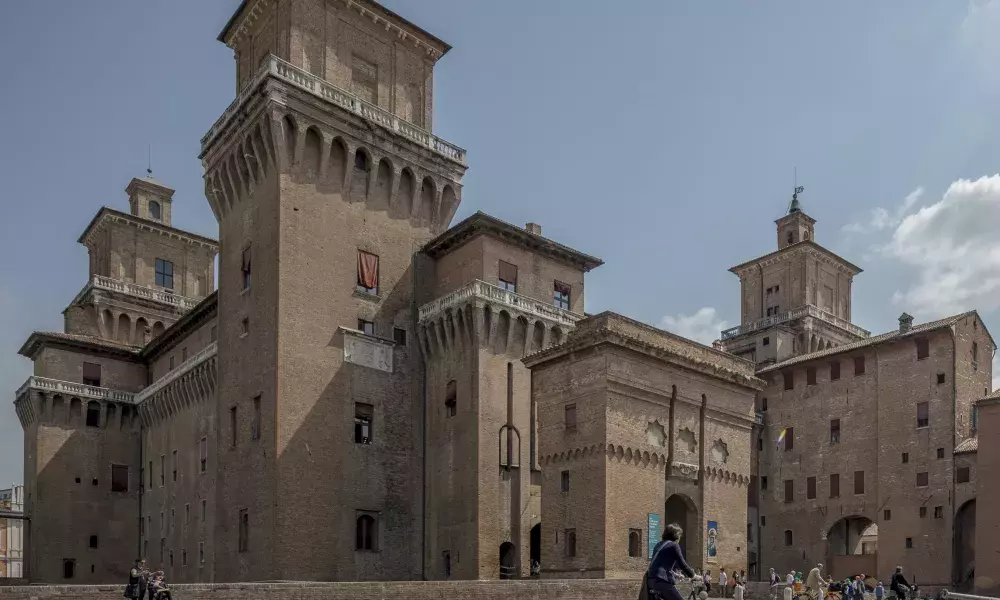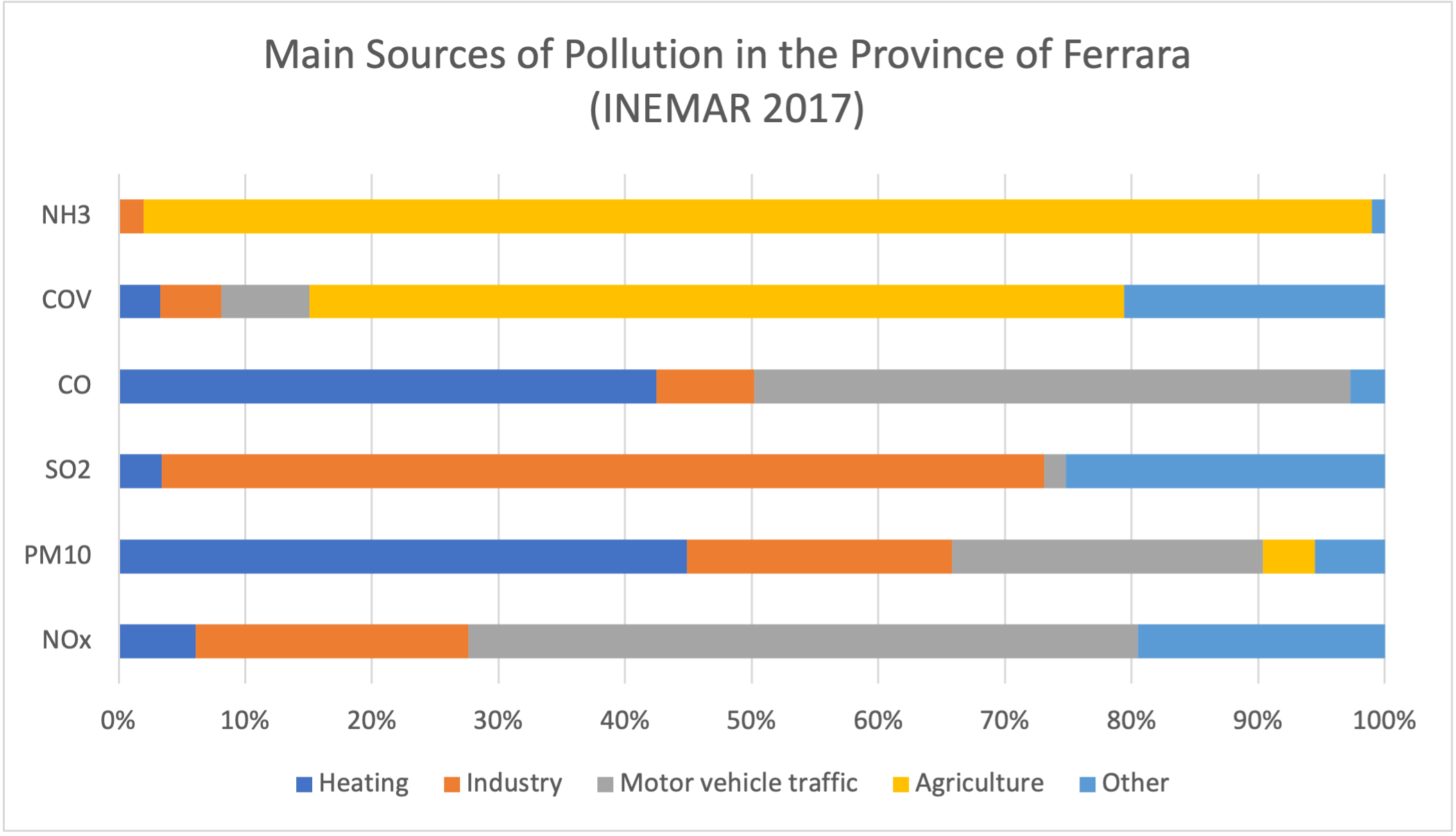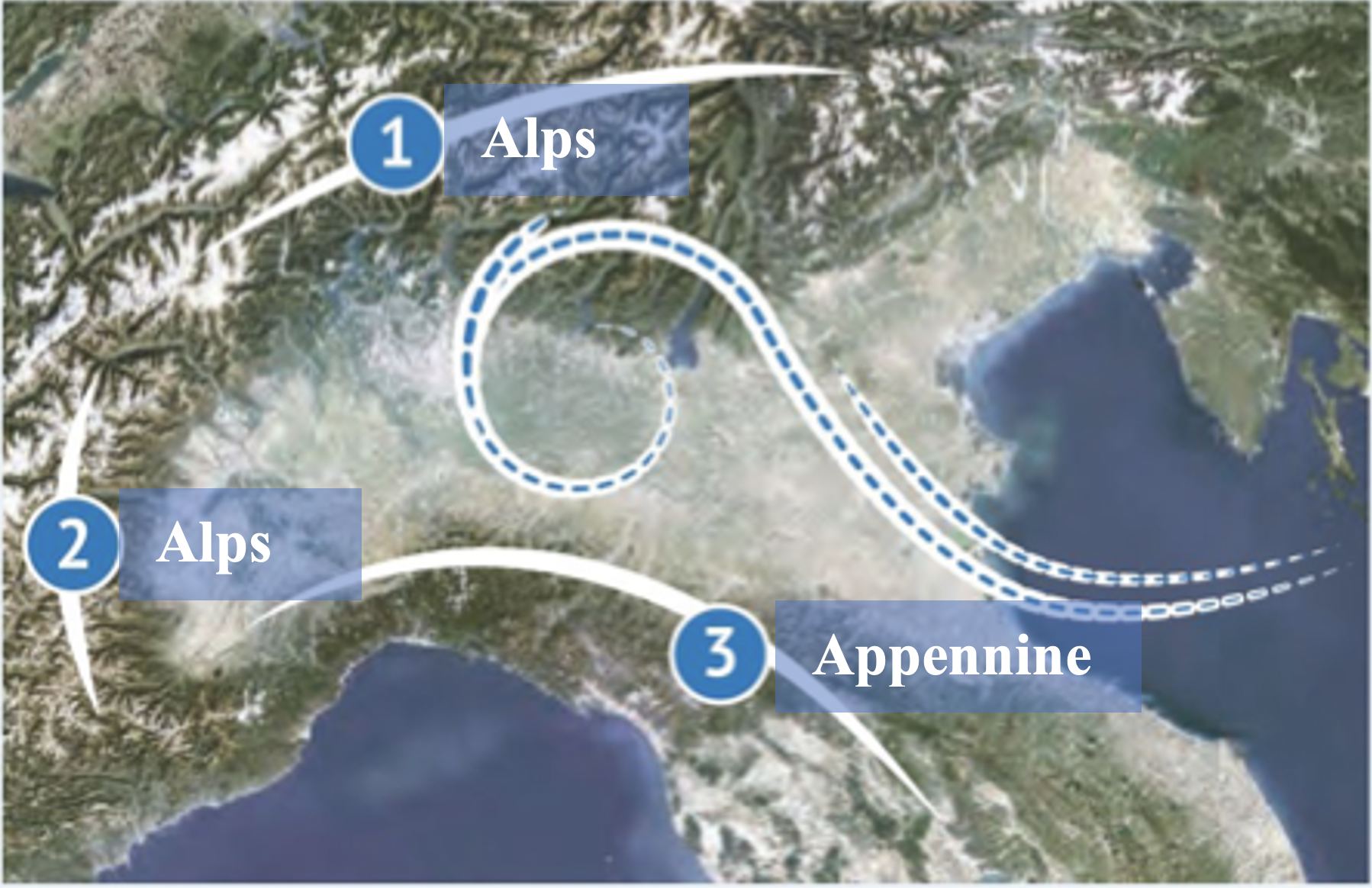
According to the World Health Organisation, air pollution affects nine out of ten people worldwide and it is the greatest environmental health threat of our time. At European level, it is perceived as the second biggest environmental concern for European citizens, after climate change (European Commission, 2017); and the improvement of air quality is increasingly becoming a priority for European, national, regional, and local policies.
As the quality of the air is strongly determined by the combination of the levels of polluting emissions with context-specific climate and geographical characteristics, urban authorities are especially affected and challenged by the issue. An issue that concerns the environmental, social, economic, and mobility dimensions, and therefore calls for truly integrated urban policies.
The Municipality of Ferrara fully acknowledges the complex and integrated nature of this challenge, and, with the Air-Break project, it stands out with an exemplary innovative approach towards its solution.
Air pollution in the city of Ferrara is the result of a multiplicity of polluting sources and stress factors, modulated by the decisive influence of meteorology. In particular:
- Overall, in the whole Province of Ferrara, polluting emissions are released in the atmosphere by four main macro-sectors of human activity: agriculture (COV, NH3); industrial production (NOx, PM10, SO2, CO); private heating (PM10, CO); and motor vehicle traffic (NOx, PM10, CO).

- The fragmented urbanization of the city’s surroundings, the lack of an adequate mobility infrastructure, the presence of a big industrial settlement in the North-West District, and a motorization rate higher than the national average, all contribute to the generation of strong private-car-based commuting fluxes mostly concentrated on four axes, where – consequently – pollution levels increase dramatically.

- Ferrara is located in a “basin” at the core of the Po River Valley, where the peculiar orography breeds meteorological conditions that are particularly unfavourable to the dispersion of pollutants. As a consequence, the Po River Valley is one of the most air-polluted areas in the World, and the city of Ferrara is among the worst affected, with serious environmental and health problems (e.g., registering cancer mortality and acute myocardial infarction rates among the highest in Italy).

Air-Break set the ambitious goal of reducing air-pollution by 25% in the most critical areas of the city. In doing so, the project will tackle air-quality issues through a set of integrated actions along four core strategic fields:
- Nature-Based Solutions, with the plantation of phyto-absorbing species along the main access roads to the city, towards the simultaneous enhancement of the quality of the green environment, as well as of its resilience and capacity to mitigate air pollution.
- Infrastructural upgrades, with the development of an innovative smart bike lane and multifunctional Smart Hubs, towards the promotion and enhancement of sustainable mobility opportunities.
- Technological equipment, with the deployment of mobile air-quality monitoring stations, as well as of innovative digital services and gamification applications, towards the incentivizing of environmentally friendly behaviours.
- Awareness-raising and citizens and stakeholders’ engagement, with the involvement of the local community in the monitoring of air-quality and establishment of a pro-active participatory process and co-design living labs, towards the strengthening of collective ownership of- and responsibility towards the project’s issues, actions and goals.
Air-Break deploys a set of innovative strategies and technologies for air-quality improvement and, at the same time, adopts a holistic, integrated approach geared towards the achievement of results clearly visible by the citizens.
Not only will Air-Break involve citizens in co-design and decision-making activities; it will also provide them with tools to constantly monitor and oversee the progress and effectiveness of the project.
The strength of Air-Break indeed lies in putting citizens, as main actors, at the centre of every action for air-quality improvement.
The Air-Break Partnership is well aware that effective measures to improve the quality of air need to tackle the source of pollution at its very root.
As we have seen, human activity is – in different forms and at different degrees – the main responsible for polluting emissions. Spanning from individual actions to widespread habits and behaviours, and from policy decisions to economic and productive models, all these types of human activity constitute the different “roots” of air-pollution. And therefore, it takes a collective, multi-stakeholder joint endeavour to bring about positive change, towards the improvement of the (possibly) most valuable of common goods: the air we breathe.
The success of Air-Break is not exempt from the need to bring together a wide spectrum of stakeholders, all committed to provide their best contribution.
This is, of course, easier said than done, as it requires a huge deal of effort at different levels. Namely:
- in identifying, reaching, and intercepting the multitude of local players and stakeholders involved and/or affected by the issue.
- in developing synergies with and among such players and stakeholders, even when their characteristics seem incompatible, their differences insurmountable, and their stakes and interests conflicting.
- and ultimately, in developing a critical mass around- and widespread ownership of the activities and goals of the project.
Yet, according to the concept of trading zones, a multiplicity of stakeholders carrying different interests and values can “generate conditions for coordinated mutual interaction despite the limited ability of each group” (Mantysalo, Balducci, and Kangasoja, 2011). In the trading zone “there are knots, local and dense sets of connections that can be identified with partially autonomous clusters of actions and beliefs” (Galison 1999). Thereby, combining actors with different goals and values within a trading zone may enable to reach a shared development vision, to gather up resources, and eventually to implement a project in a positive-sum game (Verga, 2016).
Accordingly, Air-Break is deploying an incremental, open approach towards the development of a wide and diverse critical mass of committed participants. In doing so it launched the so-called “Air-Break Alliance” and a six-months collaborative journey with local citizens and stakeholders geared towards the co-design of shared actions, initiatives, and solutions.
Air-Break collaborative journey is structured along five thematic living labs (LLs), each focused on a specific thematic strand and/or pillar of the project:
- Air Quality for All, with the aim of raising awareness around the assessment and interpretation of air-quality and environmental data, and directly engaging citizens in the gathering and measurement of local air-quality data.
- Co-Designing Smart Hubs: with the objective of co-designing the functions, services, and features of the Air-Break Smart-Hubs and their tailored integration with the target urban context; as well as with the ambition of stimulating local stakeholders and economic players to develop and deploy additional hubs, beyond those provided for by the project.
- Towards the “Air Days” (Festa dell’Aria): with the aim of collaboratively build a large “pop-science” public event, where to showcase the local innovation ecosystem; disseminate knowledge on air-quality related matters; and offer the opportunity to all interest groups, citizens, stakeholders, and authorities to meet and exchange, and ultimately develop synergies and potential collaborations.
- Green Commuting: with the aim of opening a multi-stakeholder platform, where all large traffic generators, public transportation providers, authorities, and commuters may identify shared solutions to promote and enhance sustainable mobility patterns/habits.
- Air-Break’s Actions in the City: with the twofold aim of, on the one hand, informing and consulting citizens on the physical transformations brought about by Air-Break; and on the other hand, to collaboratively envision and design potential scenarios for the future development of scaling-up initiatives and interventions.
This journey officially begun on the 6th of May 2021 with an introductory webinar on the state-of -the art of air-quality in Ferrara and it is set to continue with more than 20 (online and physical) workshops until the final event (Festa dell’Aria – Air Days) in October, where the Air-Break Alliance Charter will be signed.
The Air-break co-creation pathway builds on the design by emergence and diversity principles. While getting into the co-design process, actors and citizens develop an alliance, where energies, perspectives and doubts are shared.
These dialogues grow the space of expressing possibilities, new narratives, or potential synergies. They are moments that can inform the means for long-term ownership, contextualization of solutions and upscaling.
An Air Quality Charter will gather this set of emerging scenarios, voices, doubts, and priorities! We imagine it as an agreement and a fertile ground for innovative policy-making, heading towards more healthy spots in town!"
The project envisions the Air-Break Alliance Charter as the grounds and foundation for the development of a public-private-people sharing and collaboration platform, geared towards the achievement of the city’s air-quality improvement objectives.
As one can easily imagine, of course, the range of interest groups potentially concerned with- or affected/influenced by air-quality and green-mobility policies is extremely broad and diverse. Indeed, Air-Break wishes to involve in this process a multitude of target groups, spanning from individual citizens to organised and/or informal community groups; from environmental associations to users and advocates of different means of transportation (e.g., public transport users, private-car drivers, cyclists, etc…); from the different public transportation agencies to the providers of sustainable-mobility services; from the major generators of commuting flows on the territory (i.e., the economic actors, the university, public bodies and agencies) with their mobility managers to the students, workers and users of these urban functions and services; and ultimately from the local administration to the regional government and its environmental agencies.
In this context, the first and foremost challenge for the Air-Break Partnership is that of aligning the agendas of such a diverse multitude of actors towards a set of principles, values and objectives shared and mutually agreed upon by all participants.
Doing so will not only entail a highly complex incremental process of muddling through (Lindblom, 1959) the naturally different positions and stakes of the participants, but it will require a dedicate effort to keep the discussion “on track”.
As much as Air-Break fits into the much broader realm of air-quality and sustainable-mobility policies; it is likely that, within the same, broader policy realm, (at least a share of) the participants to the Alliance are already involved in other, parallel processes at local/regional level. Hence, it is reasonable to expect that participants might already have developed other (collaborative or conflicting) relationships with other actors; as well as they might carry stakes beyond the breath and scope of Air-Break that are not necessarily aligned with the project.
A strong leadership and a determined steering by the Air-Break Partnership will then be crucial to the success of the participatory process, to clearly set the “rules of the game”, and especially to make sure to leave out of the arena all other pre-existing issues and relationships.
Bringing together such a large and diverse wide group of stakeholders, Air-Break provides the opportunity for the activation of a new trading zone where the interactions among a wide constellation of very different actors united by a common goal may generate innovative ideas, projects, and strategies.
In other words, the trading zone activated around the Air-Break Alliance Charter has the full potential to become the catalyst and activator for additional synergies, activities, initiatives, and processes geared towards the replication and upscaling of the project’s approach and components.
Stay tuned to see the progress and achievements of the Air-Break Alliance and the release of the Charter over the next months!
European Commission, 2017. Special Eurobarometer 468: Attitudes of European citizens towards the environment (http://data.europa.eu/euodp/en/data/dataset/S2156_88_1_468_ENG)
Galison, P., 1999. Trading zone: Coordinating action and belief. in Biagioli, Mario (ed.) The Science Studies Reader. New York/London: Routledge, pp. 137-160
Lindblom CE, 1959. The science of muddling through. Public Administration Review 19(2): 79–88
Mantysalo, R., Balducci, A. and Kangasoja, J., 2011. Planning as Agonistic Negotiation in a Trading Zone, Re-examining Lindblom’s Partisan Mutual Adjustment. In Planning Theory, 10(3), pp. 257-72.
Verga, PL, 2016. Community Development as a Way-Out from Crisis. Guidelines From New York City's Experience. In Borghini, A. and Campo, E. (eds.). Exploring the Crisis: Theoretical Perspectives and Empirical Investigations. Pisa: Pisa University Press
About this resource
The Urban Innovative Actions (UIA) is a European Union initiative that provided funding to urban areas across Europe to test new and unproven solutions to urban challenges. The initiative had a total ERDF budget of €372 million for 2014-2020.
Similar content




